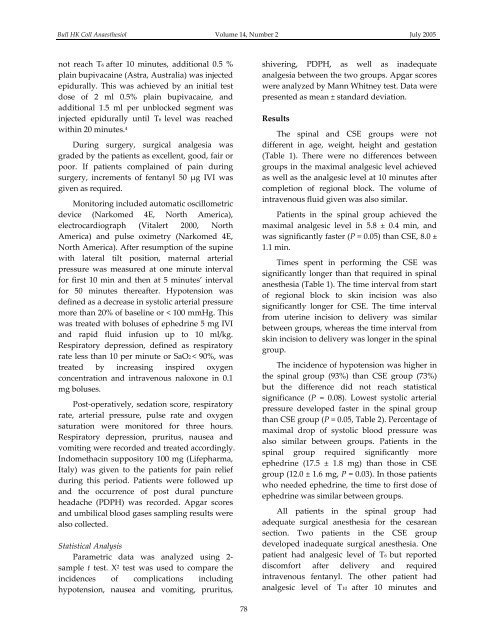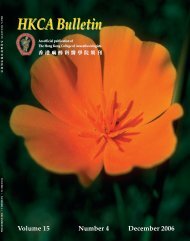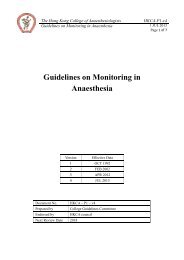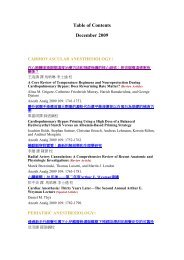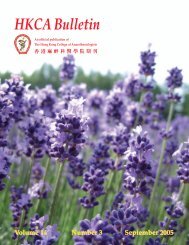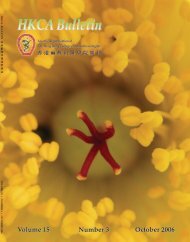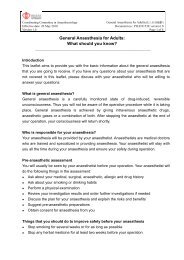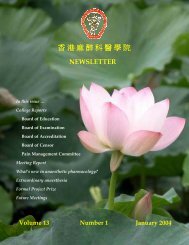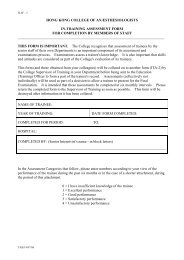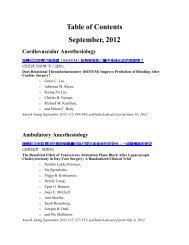July 2005 - The Hong Kong College of Anaesthesiologists
July 2005 - The Hong Kong College of Anaesthesiologists
July 2005 - The Hong Kong College of Anaesthesiologists
You also want an ePaper? Increase the reach of your titles
YUMPU automatically turns print PDFs into web optimized ePapers that Google loves.
Bull HK Coll Anaesthesiol Volume 14, Number 2 <strong>July</strong> <strong>2005</strong>not reach T6 after 10 minutes, additional 0.5 %plain bupivacaine (Astra, Australia) was injectedepidurally. This was achieved by an initial testdose <strong>of</strong> 2 ml 0.5% plain bupivacaine, andadditional 1.5 ml per unblocked segment wasinjected epidurally until T6 level was reachedwithin 20 minutes. 4During surgery, surgical analgesia wasgraded by the patients as excellent, good, fair orpoor. If patients complained <strong>of</strong> pain duringsurgery, increments <strong>of</strong> fentanyl 50 μg IVI wasgiven as required.Monitoring included automatic oscillometricdevice (Narkomed 4E, North America),electrocardiograph (Vitalert 2000, NorthAmerica) and pulse oximetry (Narkomed 4E,North America). After resumption <strong>of</strong> the supinewith lateral tilt position, maternal arterialpressure was measured at one minute intervalfor first 10 min and then at 5 minutes’ intervalfor 50 minutes thereafter. Hypotension wasdefined as a decrease in systolic arterial pressuremore than 20% <strong>of</strong> baseline or < 100 mmHg. Thiswas treated with boluses <strong>of</strong> ephedrine 5 mg IVIand rapid fluid infusion up to 10 ml/kg.Respiratory depression, defined as respiratoryrate less than 10 per minute or SaO2 < 90%, wastreated by increasing inspired oxygenconcentration and intravenous naloxone in 0.1mg boluses.Post‐operatively, sedation score, respiratoryrate, arterial pressure, pulse rate and oxygensaturation were monitored for three hours.Respiratory depression, pruritus, nausea andvomiting were recorded and treated accordingly.Indomethacin suppository 100 mg (Lifepharma,Italy) was given to the patients for pain reliefduring this period. Patients were followed upand the occurrence <strong>of</strong> post dural punctureheadache (PDPH) was recorded. Apgar scoresand umbilical blood gases sampling results werealso collected.Statistical AnalysisParametric data was analyzed using 2‐sample t test. Χ 2 test was used to compare theincidences <strong>of</strong> complications includinghypotension, nausea and vomiting, pruritus,shivering, PDPH, as well as inadequateanalgesia between the two groups. Apgar scoreswere analyzed by Mann Whitney test. Data werepresented as mean ± standard deviation.Results<strong>The</strong> spinal and CSE groups were notdifferent in age, weight, height and gestation(Table 1). <strong>The</strong>re were no differences betweengroups in the maximal analgesic level achievedas well as the analgesic level at 10 minutes aftercompletion <strong>of</strong> regional block. <strong>The</strong> volume <strong>of</strong>intravenous fluid given was also similar.Patients in the spinal group achieved themaximal analgesic level in 5.8 ± 0.4 min, andwas significantly faster (P = 0.05) than CSE, 8.0 ±1.1 min.Times spent in performing the CSE wassignificantly longer than that required in spinalanesthesia (Table 1). <strong>The</strong> time interval from start<strong>of</strong> regional block to skin incision was alsosignificantly longer for CSE. <strong>The</strong> time intervalfrom uterine incision to delivery was similarbetween groups, whereas the time interval fromskin incision to delivery was longer in the spinalgroup.<strong>The</strong> incidence <strong>of</strong> hypotension was higher inthe spinal group (93%) than CSE group (73%)but the difference did not reach statisticalsignificance (P = 0.08). Lowest systolic arterialpressure developed faster in the spinal groupthan CSE group (P = 0.05, Table 2). Percentage <strong>of</strong>maximal drop <strong>of</strong> systolic blood pressure wasalso similar between groups. Patients in thespinal group required significantly moreephedrine (17.5 ± 1.8 mg) than those in CSEgroup (12.0 ± 1.6 mg, P = 0.03). In those patientswho needed ephedrine, the time to first dose <strong>of</strong>ephedrine was similar between groups.All patients in the spinal group hadadequate surgical anesthesia for the cesareansection. Two patients in the CSE groupdeveloped inadequate surgical anesthesia. Onepatient had analgesic level <strong>of</strong> T6 but reporteddiscomfort after delivery and requiredintravenous fentanyl. <strong>The</strong> other patient hadanalgesic level <strong>of</strong> T10 after 10 minutes and78


